In time for the 43rd anniversary of Apollo 17, the all new Apollo17.org is now live!
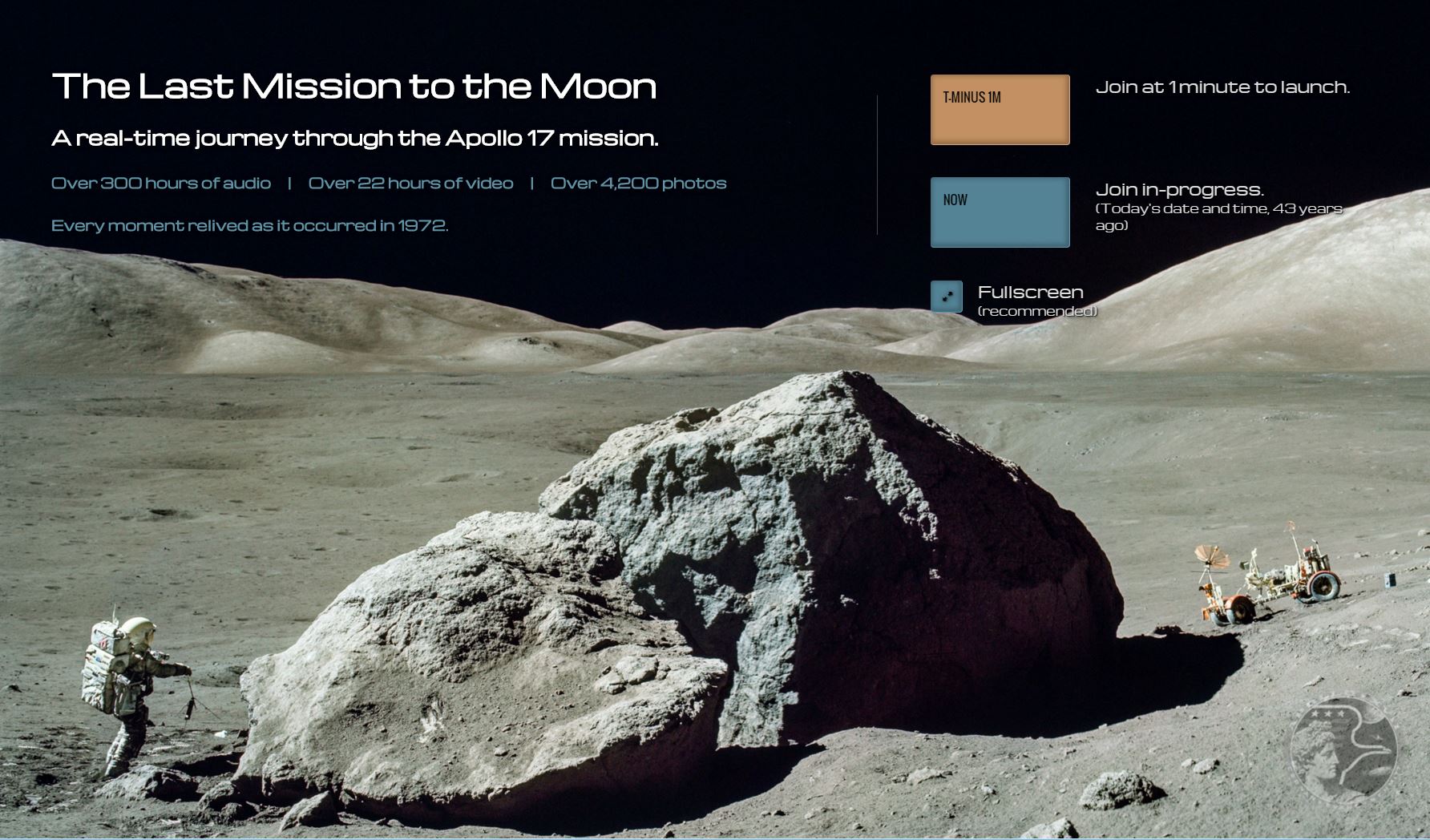
v1.0 Splash Screen
Over the past three months, I have completely rebuilt how the site works. My good friend Chris Bennett, who I have worked with on many projects in my professional career, pushed me into new territory when in September he suggested that the mission imagery was far more important and impactful than the mission commentary or transcripts. This simple, and somewhat obvious, insight had escaped me. I had worked for so long on rebuilding the transcripts that I couldn’t see past the need to make them the primary part of the experience. He provided a simple design sketch showing what a reprioritized interface might look like. This was an exciting new direction and got me rolling on a complete redesign.
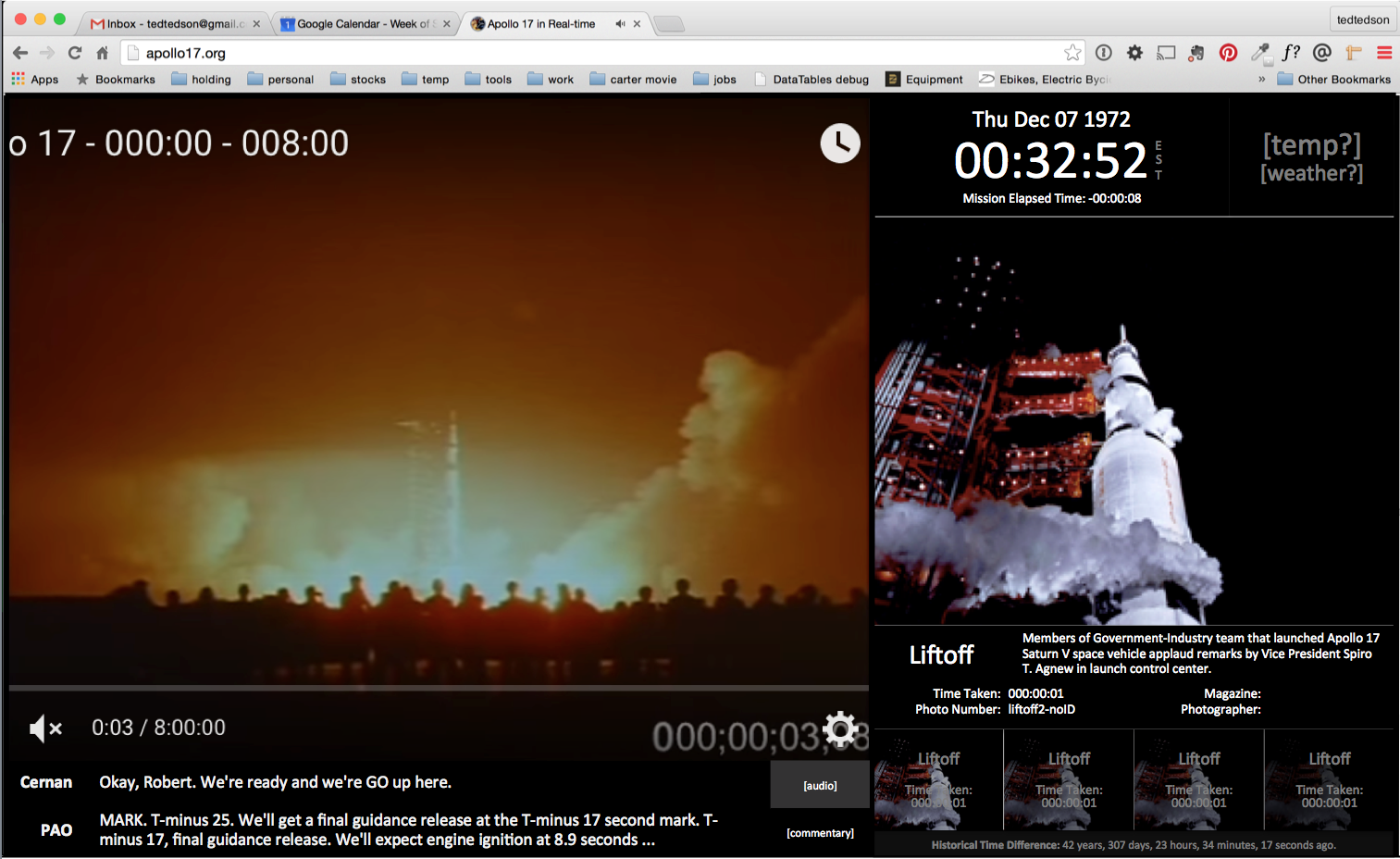
Chris Bennett’s initial media-first design direction
Suddenly Slow
Over the summer, Google had released several new versions of the Chrome browser. The new browser could not contend with the massive amount of data that I was housing in the scrolling transcript window of the old site. What was smooth and fluid in April was borderline unusable in August. I spent a week or two trying to see if it was something I was doing at the code level, but all diagnosis of the situation pointed to the underlying browser. Honestly, it’s remarkable that it worked at all to begin with. I realized that the only way to fix this would be to avoid loading the entire transcript into a scrolling window. Not only was the site going to look very different, but it would have to work differently too. I was in store for a daunting amount of coding and problem solving, but also a lot of fun.
Loading portions of the transcript window on demand meant I had a new interface problem: how could I enable users to navigate to a specific mission time if they couldn’t simply scroll the transcript to that time and click an utterance (my name for a spoken event in the transcript)? To solve this, I would have to invent a graphical interface that enabled navigation within 305.6 hours of mission data. This interface problem had been in the back of my mind for years. I was finally going to try to solve it.
Navigator Interface
I started with the design goal that the navigation scheme needed to provide a way to click on a specific event within a 305.6-hour-long mission. My calculations showed that assuming an average interface width of 1000 pixels, and a mission 1,100,166 seconds long, a line representing the mission would have a resolution of 1180.43 seconds per pixel—not fine enough to jump to a specific minute, let alone second. If I added a second line that represented 1/25th of the first line (like a zoom function), it would have a resolution of 45.75 seconds per pixel. Still not fine enough. A third level of zoom at 1/25th of the second level would get me down to 1.77 seconds per pixel. That would be fine enough to get someone in the vicinity of a particular moment. A modern laptop would have an interface more than 1000 pixels wide, getting closer to 1 second per pixel.
Over weeks of effort, I built out an interface prototype that represents time in this way. Guided Tour mission events were called out along with ticks representing utterances, photographs taken, and television broadcasted. I hope the interface isn’t too complex for the general public to figure out. It’s a pretty new idea.
Photography Data
Doing a massive amount of coding can take its toll on you. I needed breaks. It might sound crazy, but slowly chipping away at establishing when in the mission over 4,000 mission photographs were taken counted as “breaks.” It was an archival task, not a technical one. Even after all the years working on this project, I still find spending time with the mission content super interesting. The timing of photos was laborious investigative work. Often only one or two mentions of a whole magazine of photos exist in the mission audio. But by piecing together the order of activities like a jigsaw puzzle, I was able to narrow down when each particular photo was taken to a matter of minutes, or even seconds. It just took persistence. For example, often Jack Schmitt, the Lunar Module Pilot on the mission, would call out descriptions of his observations as he snapped photos from orbit. Other times, I was able to see via the television broadcasts when one of the crew was snapping photos and timed them accordingly.
Serendipitously, during my photo-timing efforts, previously unavailable high-resolution raw scans of most of the mission photos were released by Kipp Teague to much fanfare online. I wrote a program to harvest all of them from Flickr and treated them to give them correct contrast for inclusion in the site. The resulting images add immensely to the richness of the experience. They are truly spectacular.
Visual Design
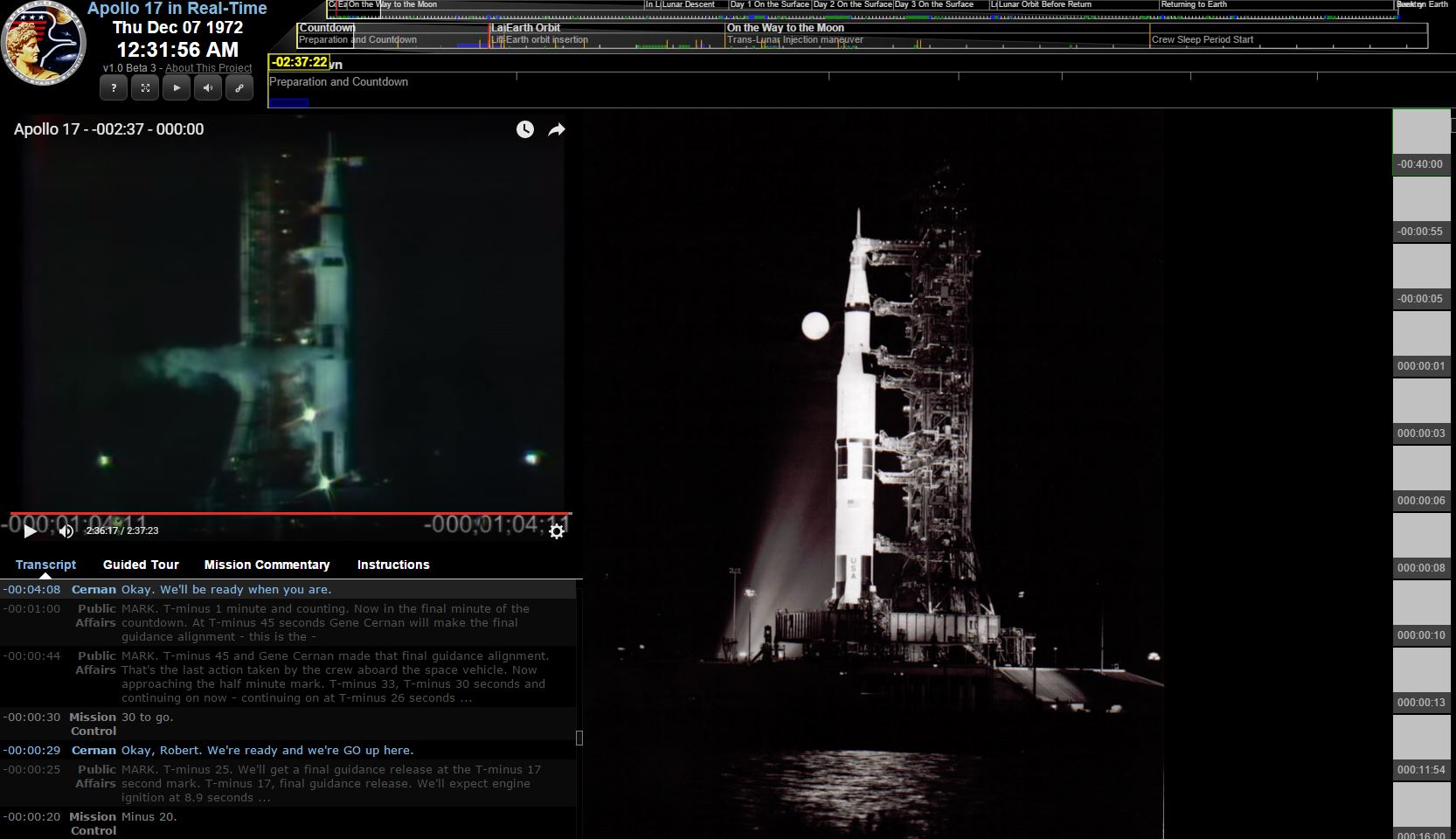
Beta3 interface before Chris Bennett’s design work
A few months into the process, I had gone as far as I could go. The site was completely functional, had a new layout, the navigator interface was singing, but the site still looked like it was built by a developer (me). I reached out again to my good friend, Chris Bennett, for help. Chris is a very talented, multidisciplinary guy. I knew he had both the coding and design skill to take the site to the next level. Chris took the layout I had arrived at (from his original recommended approach of photo-first) and applied his own visual design concept to the site. It’s truly rewarding to work with people of complementary talents. As the site took shape with Chris’s design, it went from being a personal hobby project of mine to having a life of its own. Chris also trimmed down (greatly) a lot of the copy I had written while trying to explain things on the site. The simple summary of “A real-time journey through the Apollo 17 mission. Every moment relived as it occurred in 1972.” was really all that needed to be said. I couldn’t be happier with the results of Chris’s efforts. I owe him huge.
Site Launch
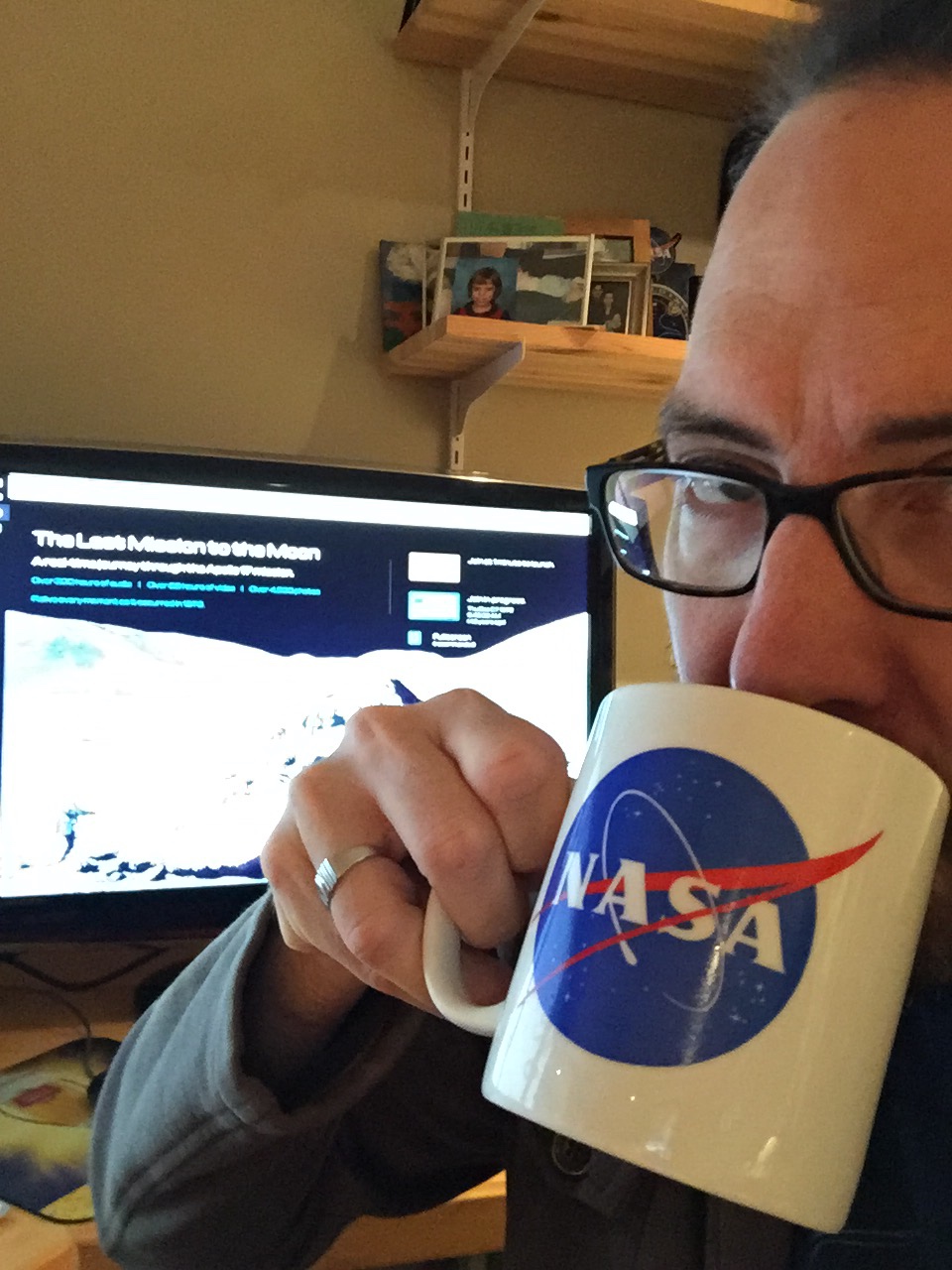
December 6th is the 43rd anniversary of the launch of Apollo 17. I hope the anniversary is a good reason for people to discover apollo17.org and dive into the great things that were achieved on the mission. The site isn’t “finished,” given that it’s a living record of what happened back in 1972—as more data becomes available and errors are discovered and corrected, the site will only become better. I hope everyone enjoys it.
Update: Dec 12/2015
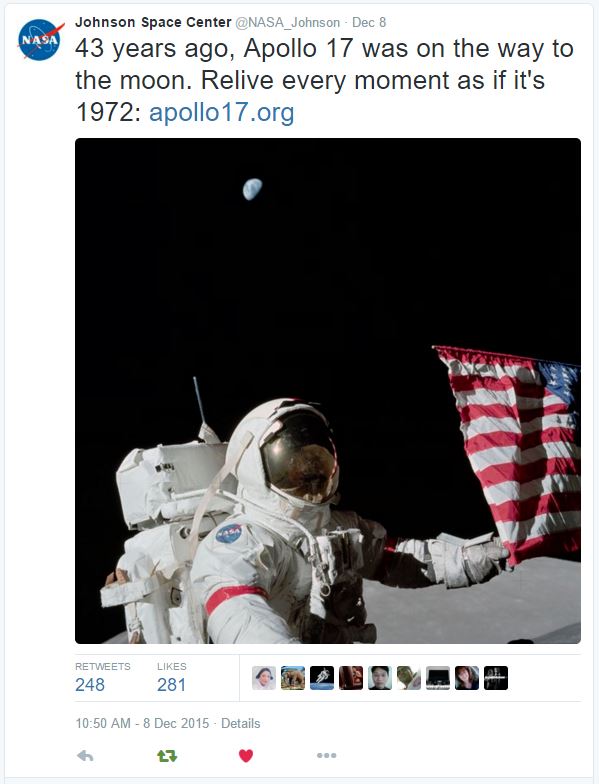
The response to the website has been nothing short of amazing. Thousands of people have visited throughout the anniversary so far, and I have received many notes of compliments and thanks. I heard through a friend close to the mission that Jack Schmitt, the Lunar Module Pilot on Apollo 17, saw the site and thought it was great. I never thought any of the crew would see the results of my efforts, and it’s humbling to know that Dr. Schmitt saw it. I also heard that Gene Kranz, Flight Director of the mission, said that I have “made the mission come alive once again.” Fantastic!
NASA’s Johnson Space Center shared apollo17.org on Facebook and Twitter. This drove a big spike in traffic and really got the word out among those interested in the history of spaceflight. It was a real compliment that they thought the site was share-worthy. Some people even thought NASA had made it. Nope.
I have also received a lot of positive feedback on the user experience. While there’s plenty of opportunity to make the experience more palatable to a broader audience, the vast majority of people not only understood how to use the site without instructions but loved how the navigation enabled them to consume such a vast amount of content. I have some ideas on how to improve the interface, but these can wait. For now, I’m going to keep spreading the word about the site during the mission anniversary as best I can.
Comments
-
agurkies (December 7, 2015 at 6:12 pm):
This is incredible. Thank you for this, thank you a lot. -
Kevin Spencer (December 7, 2015 at 9:07 pm):
This is not only beautiful, but it is art. I will certainly find myself listening and watching it during breaks, being able to pause it or head to a specific elapsed time. This was the first mission as a child where I recall the late-night launch and pieces of the complete mission. Thanks for your hard work in bringing history to life once more.- Feist (December 7, 2015 at 9:14 pm):
Thank you very much. I’m really happy that people are enjoying it. Oh, I should point out that starting at 9:55 pm EST tonight, the anniversary of the mission will have started. Watch the site in “now” mode and you’ll be synced to exactly 43 years ago to the second!
- Feist (December 7, 2015 at 9:14 pm):
-
LAHS (December 7, 2015 at 11:18 pm):
WOW! I have been sitting here for the past 30 minutes thinking about how to describe how amazing this is. Speechless, I suppose, is a good start. I could read a book about Apollo 17, or watch a documentary about it, or read it on a website, or even visit a museum, and yet none of these can compare to the experience of watching and listening to this unfold in real-time right before my eyes.- Feist (December 8, 2015 at 12:08 am):
Thanks for your kind note! The way you describe it as unpolished and raw is exactly what I was going for. There are beautifully done summaries of this mission and the Apollo program in general (When We Left Earth comes to mind), but my thought was in the age of the Internet this material doesn’t need to be editorialized. I’m hoping that people, like yourself, will take the information for what it is. After all, the drama of a landing on the moon is much greater if you’ve been along for the ride for 3 days!
- Feist (December 8, 2015 at 12:08 am):
-
Robert Stanley (December 7, 2015 at 11:37 pm):
Wonderful job on the website, folks. Thank you for your hard work. It is truly appreciated. I look forward to checking in many times over the next several days. -
Tom Rednour (December 12, 2015 at 11:08 pm):
Absolutely amazing – mesmerizing! Watching it “live” really shows the dynamics in the entire NASA crew – on the moon and on Earth.- Feist (December 13, 2015 at 12:39 pm):
Thanks, Tom. I’m glad you find the interface usable. It is a bit complex and I was worried people wouldn’t get it. It was CC, then capcom, then I changed it to mission control. I’m going to put the real names of the capcoms in at some point and have to come up with a way to make it clear to non-enthusiasts that they were at mission control.
- Feist (December 13, 2015 at 12:39 pm):
-
Marcel (December 19, 2015 at 1:33 pm):
Thank you, thank you, thank you so much for putting in the time to create this! This has been like traveling back in time and reliving an experience which I was born a little too late for!- Feist (December 19, 2015 at 2:34 pm):
Hi Marcel. Thanks so much.
- Feist (December 19, 2015 at 2:34 pm):
-
Feist (December 19, 2015 at 2:34 pm):
Hi Marcel. Thanks so much. You’ve left your comment just a few minutes before splashdown!
What a great idea to use the wake-ups as an alarm. That’s hilarious.
The site will stay online in perpetuity. There’s still more material that could be made part of the experience if I can source it. I also plan on adding maps similar to what you describe for the sections of the mission with blank video. But first, a Christmas vacation! Thanks again. -
Cyrus (December 20, 2015 at 11:37 am):
Dude, this was pure bliss. I will be making 13 solid days of time available to re-listen to every second, every precious moment of static and dead air from this thing. You’ve done humanity a great service. Any chance you could string together the other missions for us?-
Feist (December 20, 2015 at 11:52 am):
The other missions would be possible, and theoretically would be easier than this one was. That said, I’ll have to shore up this mission and the coding of the web experience before taking on any others. Thanks for writing, it means a lot to hear from people who are “getting it” to the extent I did when I was making it.- Cyrus (December 21, 2015 at 10:18 pm):
You are awesome and insane.
- Cyrus (December 21, 2015 at 10:18 pm):
-
-
G (January 3, 2016 at 9:03 pm):
This is extremely impressive work and is an absolute joy to listen to. I’m at GET 107 hours, post-LOI and a few hours before PDI for the landing. I’ve had it going almost non-stop since discovering it a few days ago.
I have to admit that I, too, would love to see the other Apollo missions that involved TLI (8, 10, 11, 13, 14, 15, and 16); maybe some organization could fund you to make that happen?
About my ONLY criticism is a web technicality… I cannot find a way to “bookmark” and continue where I left off when it freezes or I have to reload my browser; even the address in the URL bar doesn’t seem to change, so there’s no way to interject metadata to specify a time point (such as with a “t=” tag, like YouTube does, for example). The workaround is easy, I just note it in a text file and navigate back to the point.
Thanks for producing this!-
Feist (January 3, 2016 at 9:54 pm):
It’s great to hear that you’re following along and enjoying the experience. There is a way to jump back to a particular segment: use the share icon and email the current share point to yourself—or just copy the URL generated by the share functionality—this URL creates at=parameter that takes a GET. Sot=100:00:00would jump you to 100 hours into the mission.
I would love if someone wanted to fund my efforts on other missions, but I don’t know where to start in order to make that happen. It’ll have to stay a hobby for now.- F (March 24, 2016 at 7:46 pm):
LOVE THIS. REALLY REALLY DO! Why not start a Kickstarter campaign? I would certainly donate.
- F (March 24, 2016 at 7:46 pm):
-
-
Francis Faludi (January 15, 2016 at 8:09 am):
WOW, this is simply amazing. I only just began to look at this massive, fantastic work a few minutes ago but felt compelled to leave this initial feedback. Thank you so much for making this available! I think this (Apollo) era of the American space program was the last thing that the United States could be proud about.
I am going to spend a lot of time here in the coming days.- Feist (January 15, 2016 at 9:28 am):
Help yourself! I’m glad you’re enjoying it; that’s why I built it!
- Feist (January 15, 2016 at 9:28 am):
-
David (January 15, 2016 at 8:57 am):
Great work Ben!
Any thoughts about making this available on DVD or Blu-ray so internet connection isn’t required?-
Feist (January 15, 2016 at 9:27 am):
It could be built to be run offline, but it would be many Blu-ray discs in size. Perhaps for a museum installation someday, but for now, it will have to stay online.
If you would like DVD videos of the mission footage, you can buy them from Spacecraft Films.-
Cyrus (March 2, 2016 at 9:39 pm):
Hey Ben,
Is just the audio available as a series of .mp3’s? I’d like to just line it up on continual playback in my nerd bunker. Willing to pay, of course.
Cyrus-
Feist (March 3, 2016 at 11:05 am):
All audio is housed at the Internet Archive in mp3 (among other formats). Here it is in all its raw glory: Internet Archive - Apollo 17 Audio.- Cyrus (March 3, 2016 at 9:39 pm):
Ben, if I see you on the streets of Toronto, I think I might just buy you a drink.
- Cyrus (March 3, 2016 at 9:39 pm):
-
-
-
-
Ian (February 28, 2016 at 4:27 pm):
I love the website. My one suggestion is to make it a little easier to navigate to specific timelines of the mission. Right now, it is a bit of a process for me to find the start of the first EVA or the lunar liftoff, for example. It would be nice if there was a table of contents or something where I could just click on an event and get straight there. Thank you.- Feist (February 28, 2016 at 7:12 pm):
Thanks for taking the time to write, Ian. Maybe I didn’t do a good job making it obvious enough, but you can access exactly what you’re asking for by pressing the “Guided Tour” button. It brings up a list of points of interest. The items in blue are the major events, and the other items are things that I thought were interesting along the way.
- Feist (February 28, 2016 at 7:12 pm):
-
Khan Tran (March 24, 2016 at 9:08 pm):
Thank you for making this. It’s awesome stuff and layout. -
David Schwenk (March 25, 2016 at 2:16 pm):
I am just loving playing with this site: it really opened my eyes to the level of detail involved, the checklists, the process.
Wanted to pass on that I would love to see some of the animations NASA made at the time showing some of the maneuvers: perhaps for some of the stage separation sequences, and especially during the lunar module move during the initial lunar orbit injection burn sequence leaving Earth orbit.
Thank you for this!-
Feist (March 25, 2016 at 7:40 pm):
Thank you for the kind words. Can you point me to a YouTube video that contains the animations you’re referring to? I’ll integrate them if they make sense within the context of the mission.- David (March 25, 2016 at 8:30 pm):
Hey, Ben. Just did a search and this is what I imagined. NASA likely has better source and I bet they’d be happy to provide. At about the 1:13 mark: YouTube Video.
I was imagining what they would have shown on newscasts. Cheers!
- David (March 25, 2016 at 8:30 pm):
-
-
Giordanno Muñoz (October 7, 2016 at 6:42 am):
Immediately after 126:32:21 the response of the crew is missing in the transcription. I know this isn’t the place to report things, but I couldn’t find another place to do it. The site is awesome, you have done a great job with it, and I’m enjoying every minute of it.- Feist (October 13, 2016 at 11:42 am):
I’m glad you’re enjoying the site. You have found an elusive bug that I have been trying to track down for the better part of a year. If you reload the site and navigate back to the same section, the missing item will be there.
- Feist (October 13, 2016 at 11:42 am):
-
John Brandes (November 6, 2016 at 12:59 pm):
I think your site is awesome. I plan on having an Apollo 17 virtual re-enactment in a few weeks to coincide with the 44th anniversary exactly.
One question: the upper left of the screen says the mission launches on Dec 7 @ 12:32 AM. Other sources say that the time was 12:33 AM. Can you elaborate?- Feist (November 6, 2016 at 8:52 pm):
The launch occurred at 12:33 AM. The site displays 12:32 AM when it’s 1 minute to launch. 🙂
- Feist (November 6, 2016 at 8:52 pm):
-
Nelson Hernandez (November 27, 2016 at 2:08 pm):
Fantastic website. Minor suggestion: I’d recommend you put the entire transcript through Word and spell-check it. I’ve only noted one error so far (though it was done repeatedly), “spurrious” instead of spurious. Also, I noted some inaccurate times around the 0:51 minute mark. You might look for similar misalignments.- Feist (November 27, 2016 at 4:31 pm):
Thanks for the help. I’ve fixed the two “spurrious” instances. The 0:51 mark contains missing audio which is the cause of the inaccuracies. As this audio becomes available from JSC, it will be added here. Spell checking is out of the question due to the vast amount of technical and abbreviated conversation.
- Feist (November 27, 2016 at 4:31 pm):
-
Mark Fawcus (May 3, 2019 at 10:50 pm):
I’m very late finding this. I was idly searching for footage of Apollo missions, having found audio snippets, pondering the idea of patching some bits together for my own enjoyment. Then I stumbled over apollo17.org and I’m blown away! Your execution of this project is magnificent. To take on such a massive project and not only complete it but in such an engaging, easy-to-digest format is amazing.- Feist (May 4, 2019 at 8:54 am):
Thanks very much. The equivalent site for Apollo 11 is nearing completion. Watch this space.
- Feist (May 4, 2019 at 8:54 am):
-
Chris K (July 22, 2019 at 1:16 pm):
I literally found your work at the 11th hour, last week. Arrived at the office in the morning on Tuesday and thought, “I wonder if anyone has a 50th anniversary replay of the day’s activities I can listen to?” Google brought me right to apolloinrealtime.org, and just like that, I tuned in to Apollo 11, about 30 minutes before launch. I really hit the jackpot, didn’t I? I have not done anything else this past week but work, sleep, and relive this mission through your site.
Gene Krantz is correct, your work has brought this to life for me, and all week I felt as if it were a live event. Although I knew I could pause, rewind, replay at any time, I didn’t want to lose that feeling, so I would actually time certain events like my commute, grocery shopping, laundry, etc., to happen during lulls in the action, so I could get them done & get back to listening and watching in real time.
Even fell asleep one or two nights with Fido or Retro conversations playing on my tablet. Really impressed with this work, and plan on taking the Apollo 17 ride this week as well!
As a lifelong Apollo fan who doesn’t know any other Apollo fans, I can’t thank you enough for putting this together. I’m also glad to read your story here, and hear that your hard work has paid off. If you ever get the itch to do another mission, I’m kinda partial to 12, which launched on my 4th birthday & I’d gladly lend a hand!
Thanks, Ben, for all your efforts, I really love it.